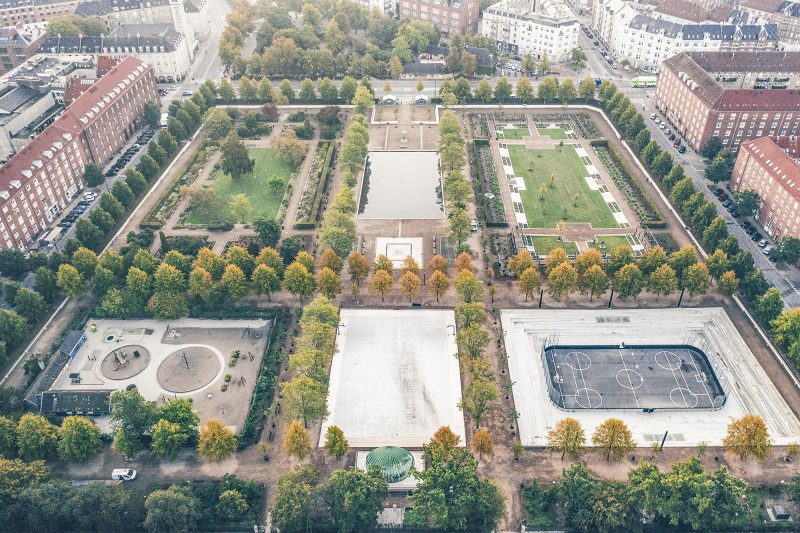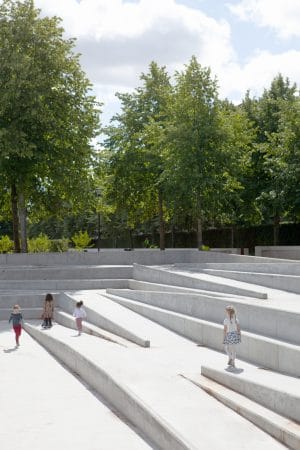Solution provider

We are an architectural office specialized in the fields of climate adapted landscapes, hybrid buildings and sustainable urban planning.
Case


We are an architectural office specialized in the fields of climate adapted landscapes, hybrid buildings and sustainable urban planning.
Add the case to your visit request and let us know that you are interested in visiting Denmark
The historical park Enghaveparken that holds designs by the design icon Arne Jacobsen recently opened in a redesigned version. The park has been transformed into the largest climate project in Copenhagen. With a 22.600 m3 water reservoir the park answers the need to handle future water challenges. The new Climate Park has just received the prestigious Danish architecture award ‘Årets Arne’, named after Arne Jacobsen.
FACTS
Client: City of Copenhagen, Greater Copenhagen Utility (HOFOR), Areal Renewal Project
Place: Copenhagen, Denmark
Size: 35,000 m2 (380,000 sf)
Cloudburst Capacity: 22,600 m3 (800,000 ft3)
Team: COWI, THIRD NATURE and Platant
Period: 2014-2020
Enghaveparken is a beloved park from the 1920s with a timeless neoclassicist design. With the redesign of Enghaveparken, the team THIRD NATURE, COWI and Platant has given practical and aesthetic answers to an urgent dilemma: how do we honor our design legacies while also adapting our cities to the reality of the 21st century's more extreme climate?
THE SOLUTION OF A CATCH-22 SITUATION
In the 2010s Copenhagen - and Vesterbro in particular - has been hardly hit by cloud bursts resulting in floods and extremely costly damages. With Enghaveparken’s location at the bottom of a hill, the park has become a strategic location in the handling of extreme rain.
The task the team was given was to find space for 22.6000 m3 of rainwater in the park, while honouring the simplicity of the park's historical design. With the new Enghaveparken, we have made room for 9.000 cubic metres of rainwater by excavating within the neoclassicist structure of the park. On top of that, a low wall has been built along the perimeter of the park, to hold back further 13.600 cubic meters of water. In dry periods the levee can also be used as for play and as a bench for sitting. A mechanism that automatically pushes up the gates of the perimeter wall has been invented so that the climate adaptive elements of the park function even without electricity. In case of extreme rain, the automated gates will shut down the park to the public, and the park will mirror the adjacent buildings while sparing them from the extreme rain.

A NEOCLASSICAL DESIGN
The park is built as a strict neoclassical park with a reflecting pool, geometric axes, playground and stage. The structure in the park has been preserved and enforced with the restoration of the tree alleys going through the park. The different areas in the park are formed in Enghaveparken’s original character and designed with great additions of new experiences and an enhanced biodiversity that will help make the park attractive to the eye and mind all year and create habitats for urban wildlife as insects and small animals. The original pavilions by Arne Jacobsen have been rebuilt and placed at the entrance of the park. The renewal of the original designs of Enghaveparken will reinforce its cultural values and telling.
ROOFTOP WATER RECYCLED AND DELAYED
The transformation of the park has turned the water challenges to a variety of new experiences for recreation and interaction. When it rains within normal measures, the rainwater from the nearby roofs will be led to the park and to a retention basin. Here, the rainwater will be stored and used for watering a diverse range of plants and trees during dry spells and can even be used to clean the streets of Copenhagen. At the same time, the rainwater is handled above ground in the multifunctional cloudburst reservoir and the encircling dike. The rainwater is circulated in a channel on top of the dike, so visitors can run their hands through the water and the water is also utilised in an adjacent fountain garden where kids can play. With this re-use of rainwater, we save millions of litres of groundwater, which is the usual source of water for recreational purposes. When the retention basin empties after extended dry periods, the recreational water functions disappear. Hereby, we are coupling the technical water solutions with a sensuous dimension and a causal understanding of resources. Thereby, the new Enghaveparken is both an aesthetic and conceptual space for reflections on the climate crisis.
ÅRETS ARNE
Enghaveparken Climate Park has just received the coveted award ‘Årets Arne’, a regional prize named after Arne Jacobsen. The award is given by the Danish Association of Architects to a project that significantly heightens the quality of Danish architecture.